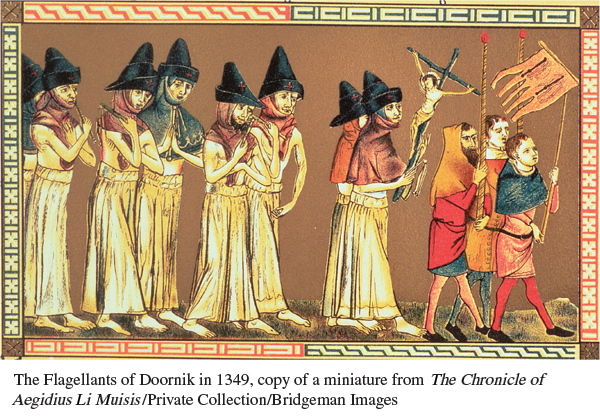A History of Western Society: Printed Page 330
A History of Western Society, Value Edition: Printed Page 317
A History of Western Society, Concise Edition: Printed Page 330
Economic, Religious, and Cultural Effects
Economic historians and demographers sharply dispute the impact of the plague on the economy in the late fourteenth century. The traditional view that the plague had a disastrous effect has been greatly modified. By the mid-
The Black Death did bring on a general European inflation. High mortality produced a fall in production, shortages of goods, and a general rise in prices. The price of wheat in most of Europe increased, as did the costs of meat, sausage, and cheese. This inflation continued to the end of the fourteenth century. But labor shortages resulting from the high mortality caused by the plague meant that workers could demand better wages, and the broad mass of people who survived enjoyed a higher standard of living. The greater demand for labor also meant greater mobility for peasants in rural areas and for artisans in towns and cities.
The plague also had effects on religious practices. Despite Boccaccio’s comments about family members’ coldness, people were saddened by the loss of their loved ones, especially their children. Not surprisingly, some people sought release from the devastating affliction in wild living, but more became more deeply pious. Rather than seeing the plague as a medical issue, they interpreted it as the result of an evil within themselves. God must be punishing them for terrible sins, they thought, so the best remedies were religious ones: asking for forgiveness, praying, trusting in God, making donations to churches, and trying to live better lives. John VI Kantakouzenos reported that in Constantinople, “many of the sick turned to better things in their minds . . . they abstained from all vice during that time and they lived virtuously; many divided their property among the poor, even before they were attacked by the disease.”4 In Muslim areas, religious leaders urged virtuous living in the face of death: give to the poor, reconcile with your enemies, free your slaves, and say a proper good-
Believing that the Black Death was God’s punishment for humanity’s wickedness, some Christians turned to the severest forms of asceticism and frenzied religious fervor, joining groups of flagellants (FLA-
Along with seeing the plague as a call to reform their own behavior, however, people also searched for scapegoats, and savage cruelty sometimes resulted. As in the decades before the plague, many people believed that the Jews had poisoned the wells of Christian communities and thereby infected the drinking water. Others thought that killing Jews would prevent the plague from spreading to their town, a belief encouraged by flagellant groups. These charges led to the murder of thousands of Jews across Europe, especially in the cities of France and Germany. In Strasbourg, for example, several hundred Jews were publicly burned alive. Their houses were looted, their property was confiscated, and the remaining Jews were expelled from the city.

The literature and art of the late Middle Ages reveal a people gripped by morbid concern with death. One highly popular literary and artistic motif, the Dance of Death, depicted a dancing skeleton leading away living people, often in order of their rank. (See “Evaluating the Evidence 11.1: Dance of Death.”) In the words of one early-
Death spareth not low nor high degree
Popes, Kings, nor worthy Emperors
When they shine most in felicity
He can abate the freshness of their flowers
Eclipse their bright suns with his showers . . .
Sir Emperor, lord of all the ground,
Sovereign Prince, and highest of nobles
You must forsake your round apples of gold
Leave behind your treasure and riches
And with others to my dance obey.5
The years of the Black Death witnessed the foundation of new colleges at old universities and of entirely new universities. The foundation charters explain the shortage of priests and the decay of learning as the reasons for their establishment. Whereas older universities such as those at Bologna and Paris had international student bodies, these new institutions established in the wake of the Black Death had more national or local constituencies. Thus the international character of medieval culture weakened, paving the way for schism (SKIH-
As is often true with devastating events, the plague highlighted central qualities of medieval society: deep religious feeling, suspicion of those who were different, and a view of the world shaped largely by oral tradition, with a bit of classical knowledge mixed in among the educated elite.